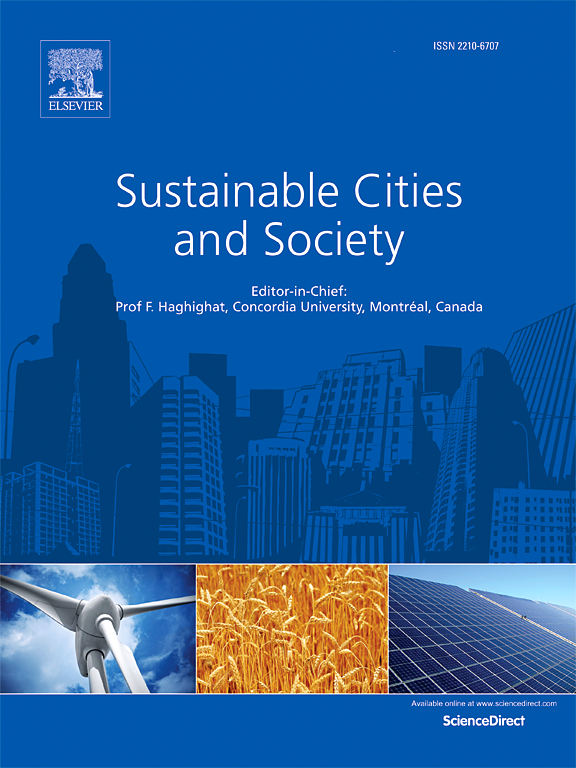The impact of high-density urban spatial form on urban vertical ventilation and thermal comfort in extreme cold region
IF 10.5
1区 工程技术
Q1 CONSTRUCTION & BUILDING TECHNOLOGY
引用次数: 0
Abstract
The influence of the spatial form and roughness of an actual urban area on the distribution of the comfort zone of the wind and thermal environment is crucial for the liveable and sustainable development of urban spaces. Four cases in Harbin, a high-density city in an extremely cold region, were selected as the analysis objects, with six spatial shape parameters and two aerodynamic roughness parameters. The overall urban status was simulated by computational fluid dynamics and the thermal environment. The results showed that in spaces containing buildings, the urban spatial form significantly affected the aerodynamic roughness of the city. The comfortable wind speed decreases by 16.30–23.96 percentage points in the main rough surface and by 6.29 to 7.52 percentage points in a non-thermal stress environment. The prediction and interpretation degree of the influence of the morphological parameters of the comfortable wind and thermal environment was high. The numerical limit of the spatial morphological parameters was also clarified to ensure that the wind comfort was higher than 66.36 %, and the thermal comfort was higher than 22.83 %. Priority was given to controlling the spatial building height and distribution density. These findings provide valuable spatial impact results for the initial layout stage of urban space planning and a set of simulation frameworks for large-scale urban spaces, making it possible to simulate and analyse the wind and thermal environments of high-density urban spaces in extremely cold regions.
高密度城市空间形态对极寒地区城市垂直通风和热舒适的影响
实际城市区域的空间形态和粗糙度对风热环境舒适区分布的影响对于城市空间的宜居和可持续发展至关重要。选取极寒地区高密度城市哈尔滨的4个案例作为分析对象,选取6个空间形状参数和2个气动粗糙度参数。利用计算流体力学和热环境模拟了城市的整体状态。结果表明:在包含建筑的空间中,城市空间形态对城市的气动粗糙度有显著影响。主要粗糙面舒适风速下降16.30 ~ 23.96个百分点,非热应力环境舒适风速下降6.29 ~ 7.52个百分点。对舒适风热环境形态参数影响的预测和解释程度较高。明确了空间形态参数的数值上限,确保风舒适度大于66.36%,热舒适度大于22.83%。重点控制空间建筑高度和分布密度。这些发现为城市空间规划的初始布局阶段提供了有价值的空间影响结果,并为大规模城市空间提供了一套模拟框架,为模拟和分析极寒地区高密度城市空间的风热环境提供了可能。
本文章由计算机程序翻译,如有差异,请以英文原文为准。
求助全文
约1分钟内获得全文
求助全文
来源期刊

Sustainable Cities and Society
Social Sciences-Geography, Planning and Development
CiteScore
22.00
自引率
13.70%
发文量
810
审稿时长
27 days
期刊介绍:
Sustainable Cities and Society (SCS) is an international journal that focuses on fundamental and applied research to promote environmentally sustainable and socially resilient cities. The journal welcomes cross-cutting, multi-disciplinary research in various areas, including:
1. Smart cities and resilient environments;
2. Alternative/clean energy sources, energy distribution, distributed energy generation, and energy demand reduction/management;
3. Monitoring and improving air quality in built environment and cities (e.g., healthy built environment and air quality management);
4. Energy efficient, low/zero carbon, and green buildings/communities;
5. Climate change mitigation and adaptation in urban environments;
6. Green infrastructure and BMPs;
7. Environmental Footprint accounting and management;
8. Urban agriculture and forestry;
9. ICT, smart grid and intelligent infrastructure;
10. Urban design/planning, regulations, legislation, certification, economics, and policy;
11. Social aspects, impacts and resiliency of cities;
12. Behavior monitoring, analysis and change within urban communities;
13. Health monitoring and improvement;
14. Nexus issues related to sustainable cities and societies;
15. Smart city governance;
16. Decision Support Systems for trade-off and uncertainty analysis for improved management of cities and society;
17. Big data, machine learning, and artificial intelligence applications and case studies;
18. Critical infrastructure protection, including security, privacy, forensics, and reliability issues of cyber-physical systems.
19. Water footprint reduction and urban water distribution, harvesting, treatment, reuse and management;
20. Waste reduction and recycling;
21. Wastewater collection, treatment and recycling;
22. Smart, clean and healthy transportation systems and infrastructure;
 求助内容:
求助内容: 应助结果提醒方式:
应助结果提醒方式:


